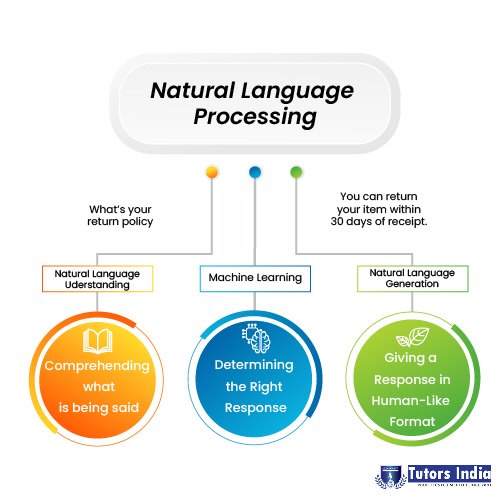Semantic Search Using Natural Language Processing
Introduction
Computer-assisted text analysis is known as natural language processing (NLP). An aspect of NLP is the study of how someone uses and understands language. The goal of this is to develop the tools and methods necessary for computer systems to comprehend, change, and perform a wide range of useful tasks using natural language. Researches in NLP are currently focused on creating sophisticated NLP systems that incorporate both the general text and a sizable portion of the ambiguity and unpredictability of a language. Computational linguistics frequently faces problems with speech recognition, word separation, and other concepts. In NLP, it has been usual practise to create statistical approaches for it (Bast et al., 2016).

Figure 1: Natural Language Processing (NLP) Kim (2020)
Semantic Search Reduces Searching And Increases Finding
Since its creation in the early 1990s, the essential search engine has made tremendous advancements. However, it has recently made tremendous strides toward providing much more nuanced and pertinent solutions with the use of artificial intelligence (AI) technologies like machine learning (ML) and natural language processing. AI skills are added to search engines to develop semantic search. No longer are searches restricted to words and their definitions from dictionaries: Understanding the query’s goal and describing the data such that it is “suited for meaningful retrieval,” as stated in Towards Data Science, are necessary for semantic search” (Do et al., 2010).
By learning from prior query results, Semantic Search uses machine learning to increase accuracy and relevance. By using NLP, the searcher is able to formulate their inquiries as if they were speaking to a human. They might spend less time coming up with the best keywords for a particular search as a result. Unlike its keyword-based predecessor, semantic search can handle informations from a wide range of sources, including email, social media, documents, PDFs, images, video, and audio. This considerably expands the searcher’s possibilities by enabling them to find what they’re looking for using all of the resources at their disposal (Sheu et al., 2009).
Semantic Research Is A Variable Investment Worth Making For Organizations
There has never been a business that wouldn’t benefit from obtaining quicker, more precise, and higher-quality results. By eliminating unnecessary information and only displaying the most correct answers, semantic search enables less searching and more discovery.
Considering the example of an underwater welder searching for supplies to complete a task on a 1,500-foot-deep oil rig in the Gulf of Mexico. A keyword search would only give up results pertaining to welding, thereby omitting the multifaceted nature of this endeavour. The context of such a project would be recognised by a semantic search, together with the fact that the welder is second in importance to the diver in the searcher’s profile. In addition to taking into account factors like working conditions and water currents, it would offer pertinent results, such as those from a hyperbaric chamber.
Semantic search may provide further business benefits by merging NLP with an intuitive user interface and making it straightforward for anyone to interact with and get the results they’re looking for. Fast access to accurate findings facilitates decision-making and increases productivity in businesses of all sizes. By combining unstructured data from many sources, semantic search may also aid in the expansion and success of enterprises (Kupiyalova et al., 2020).
What Are Some Examples Of Semantic Research?
Interestingly, since the Hummingbird upgrade in 2013, Google has been embracing semantic search to enhance its user experience. With this improvement, “conversational search” was introduced to its repertoire, meaning that the context of the full query was taken into account rather than just certain phrases.
Online retailer Zappos just integrated semantic search to their website to make it easier for customers to locate exactly what they’re looking for. The algorithm adapts the result to each customer’s prior search data, according to the company’s chief data scientist, in addition to understanding the context of the search word (Wei et al., 2008). As a result, Zappos is in a position to offer each of its customers the results that are specifically relevant to them.
Companies all around the world are turning to services like Microsoft Azure and AWS Comprehend, which enable them to use the technologies without having to build it themselves, as the advantages of semantic search become more and more clear.
Conclusion
In order to ensure that no crucial information is overlooked, effectively using semantic search also requires destroying any internal data silos that may exist (Cotfas et al., 2019). By making sure that employees are forthcoming with the necessary information and that adequate technical preparation is in place, organisations may train their conceptual search engine to produce the most informed and accurate results.
Nevertheless, much study remains to be done, despite the fact that semantic search may seem to be a mature technology. That is not to imply that we shouldn’t start using it today in order to benefit from its many benefits rather than waiting till technology reaches its full potential: Semantic search may be used by companies of all sizes to help them make decisions more quickly and thoroughly, enhance customer experience, and increase revenue (Sangers et al., 2013).
References
- Bast, H., Buchhold, B. & Haussmann, E. (2016). Semantic Search on Text and Knowledge Bases. Foundations and Trends® in Information Retrieval, 10 (1). pp. 119–271. DOI: 10.1561/1500000032.
- Cotfas, L.-A., Roxin, I. & Delcea, C. (2019). Semantic search in social media analysis. In: Proceedings of the 18th International Conference on Conference on Informatics in Economy (IE 2019). 2019, pp. 37–42.
- Do, B.H., Wu, A., Biswal, S., Kamaya, A. & Rubin, D.L. (2010). Informatics in Radiology: RADTF: A Semantic Search–enabled, Natural Language Processor–generated Radiology Teaching File. RadioGraphics, 30 (7). pp. 2039–2048. DOI: 10.1148/rg.307105083.
- Kim (2020). Improve Your Apps With Natural Language Processing.
- Kupiyalova, A., Satybaldiyeva, R. & Aiaskarov, S. (2020). Semantic search using Natural Language Processing. In: 2020 IEEE 22nd Conference on Business Informatics (CBI). June 2020, IEEE, pp. 96–100. DOI: 10.1109/CBI49978.2020.10065.
- Sangers, J., Frasincar, F., Hogenboom, F. & Chepegin, V. (2013). Semantic Web service discovery using natural language processing techniques. Expert Systems with Applications, 40 (11). pp. 4660–4671. DOI: 10.1016/j.eswa.2013.02.011.
- Sheu, P.C.-Y., Wang, S., Wang, Q., Hao, K. & Paul, R. (2009). Semantic Computing, Cloud Computing, and Semantic Search Engine. In: 2009 IEEE International Conference on Semantic Computing. September 2009, IEEE, pp. 654–657. DOI: 10.1109/ICSC.2009.51.
- Wei, W., Barnaghi, P.M. & Bargiela, A. (2008). Search with meanings: an overview of semantic search systems. International journal of Communications of SIWN, 3. pp. 76–82.

 Previous Post
Previous Post Next Post
Next Post